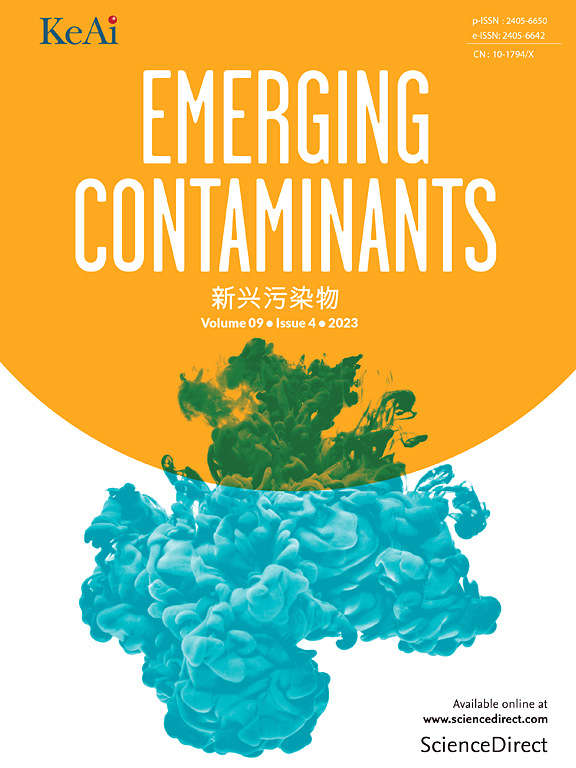Occurrence, accumulation and potential toxicity of parent and halogenated polycyclic aromatic hydrocarbons in pooled serum of people in different age groups from four Chinese cities
IF 6.9
2区 环境科学与生态学
Q1 ENVIRONMENTAL SCIENCES
引用次数: 0
Abstract
Halogenated polycyclic aromatic hydrocarbons (HPAHs) and polycyclic aromatic hydrocarbons (PAHs) were determined in human serum samples pooled by donor age (<20, 20–29, 30–39, 40–49 and ≥ 50 y). The pooled samples were collected from four Chinese cities, Yantai (Shandong Province), Ganzi (Sichuan Province), Huaihua (Hunan Province), and Lingshui (Hainan Province). The concentrations of HPAHs and PAHs were in the range of 4.26–633 ng/g lipid and 249–1642 ng/g lipid from the different cities. Although the levels of HPAHs in blood samples varied among the populations of the four cities, 1,5-dichloroanthracene (1,5-Cl2Ant) was the predominant contributor to HPAHs in the serum samples, accounting for over 85.7 % of its total concentration. Furthermore, 1,5-Cl2Ant serum concentrations increased significantly with age. Notably, molecular docking results show that 1,5-Cl2Ant not only acquires the ability to bind d-AhR PAS-B domain, but also binds at the similar sites as 2,3,7,8-tetrachlorodibenzo-p-dioxin (TCDD) and benzo[a]pyrene (BaP), suggesting that 1,5-Cl2Ant, like TCDD and BaP, may cause a wide variety of toxicity via AhR-mediated signaling pathways. The bioaccumulation potential of 1,5-Cl2Ant in the human body and its associated toxicity observed in this study need special attention.

中国4个城市不同年龄组人群血清中母体和卤代多环芳烃的存在、积累及潜在毒性
按供体年龄(20岁、20 - 29岁、30-39岁、40-49岁和≥50岁)分组的人血清样品中测定卤代多环芳烃(HPAHs)和多环芳烃(PAHs)。汇集的样本来自中国4个城市:山东省烟台市、四川省甘孜市、湖南省怀化市和海南省陵水市。各城市的HPAHs和PAHs浓度分别为4.26 ~ 633 ng/g脂质和249 ~ 1642 ng/g脂质。虽然4个城市人群血样中HPAHs的含量存在差异,但1,5-二氯蒽(1,5- cl2ant)是血清样本中HPAHs的主要来源,占总浓度的85.7%以上。此外,1,5- cl2ant血清浓度随年龄的增长而显著升高。值得注意的是,分子对接结果表明,1,5- cl2ant不仅获得了结合d-AhR PAS-B结构域的能力,而且还与2,3,7,8-四氯二苯并-对二恶英(TCDD)和苯并[a]芘(BaP)结合在相似的位点,这表明1,5- cl2ant可能像TCDD和BaP一样,通过ahr介导的信号通路引起多种毒性。本研究观察到的1,5- cl2ant在人体内的生物蓄积潜力及其相关毒性值得特别关注。
本文章由计算机程序翻译,如有差异,请以英文原文为准。
求助全文
约1分钟内获得全文
求助全文
来源期刊

Emerging Contaminants
Medicine-Public Health, Environmental and Occupational Health
CiteScore
10.00
自引率
6.70%
发文量
35
审稿时长
44 days
期刊介绍:
Emerging Contaminants is an outlet for world-leading research addressing problems associated with environmental contamination caused by emerging contaminants and their solutions. Emerging contaminants are defined as chemicals that are not currently (or have been only recently) regulated and about which there exist concerns regarding their impact on human or ecological health. Examples of emerging contaminants include disinfection by-products, pharmaceutical and personal care products, persistent organic chemicals, and mercury etc. as well as their degradation products. We encourage papers addressing science that facilitates greater understanding of the nature, extent, and impacts of the presence of emerging contaminants in the environment; technology that exploits original principles to reduce and control their environmental presence; as well as the development, implementation and efficacy of national and international policies to protect human health and the environment from emerging contaminants.
 求助内容:
求助内容: 应助结果提醒方式:
应助结果提醒方式:


